Trying to decide between Tai Chi or yoga for better health, stress relief, or flexibility? Both have deep traditions and solid science behind them, but the right pick depends on what you want. Yoga and Tai Chi both reduce stress, boost your mood, and improve your balance and strength, but they get there with different movements and philosophies (tai chi vs yoga, difference between tai chi and yoga).
Whichever you try, you’ll get gentle movement, better breathing, and a stronger mind-body connection. What’s best for you really depends on whether you want more mental calm, flexibility, mobility, or endurance (tai chi yoga health benefits). Let’s break down the benefits of each so you can figure out what fits your needs.
Key Takeaways
- Tai Chi and yoga both offer body and mind benefits
- Your specific goals help determine which practice suits you best
- It’s possible to integrate both into your daily routine
Understanding Tai Chi and Yoga

Tai Chi and Yoga are both mind-body practices, but they use different techniques and philosophies. Both can help your physical and mental well-being, but they come from very different backgrounds and have their own unique movements and principles.
What Is Tai Chi?
Tai Chi, or tai chi chuan, started in China as a gentle form of exercise. You move through slow, flowing motions, keeping your body relaxed and your mind focused. Each movement blends into the next, almost like a slow-motion dance.
You breathe steadily as you move and pay attention to your balance. Tai Chi often mixes in qigong, which aims to strengthen your “qi” or life energy. Because it’s low-impact, most people can do it. Many folks use it to support balance, muscle strength, and relaxation—especially older adults or anyone wanting a gentle way to stay active.
A lot of people find Tai Chi both calming and energizing. You don’t need special equipment, and you can practice solo or with others. Tai Chi can improve muscle strength, balance, and flexibility.
What Is Yoga?
Yoga comes from India and blends physical postures, breathing, and sometimes meditation. In yoga, you focus on poses (asanas) that stretch and strengthen your body in different ways.
Yoga also uses breathing techniques and relaxation exercises. These help you stay calm and centered while you hold the poses. There are tons of yoga styles—some are super gentle, others can get pretty intense.
You don’t need much for yoga besides a mat, and you can do it in a class, at home, or online. Yoga helps with flexibility, strength, stress relief, and heart health. Many people lean on yoga to manage stress, improve posture, and just feel better in their bodies.
Origins and Philosophy
Tai Chi and Yoga both go way back, but they come from totally different cultures. Tai Chi began in ancient China and ties into martial arts and Chinese medicine. It’s about more than self-defense—it’s really for health and inner balance. The roots are mixed up with ideas like yin and yang, and it often uses qigong to focus on energy flow.
Yoga started in India thousands of years ago. Its teachings come from old texts and ideas about body, breath, and mind. The philosophy is about uniting body and mind with spirit. Harmony, self-awareness, and breath control are at the core.
While both practices use breathing and mindful movement to connect your body and mind, their histories shape how they’re taught and what you get out of them. Both care about balance, but they each have their own traditions and flavor.
Core Principles and Practices
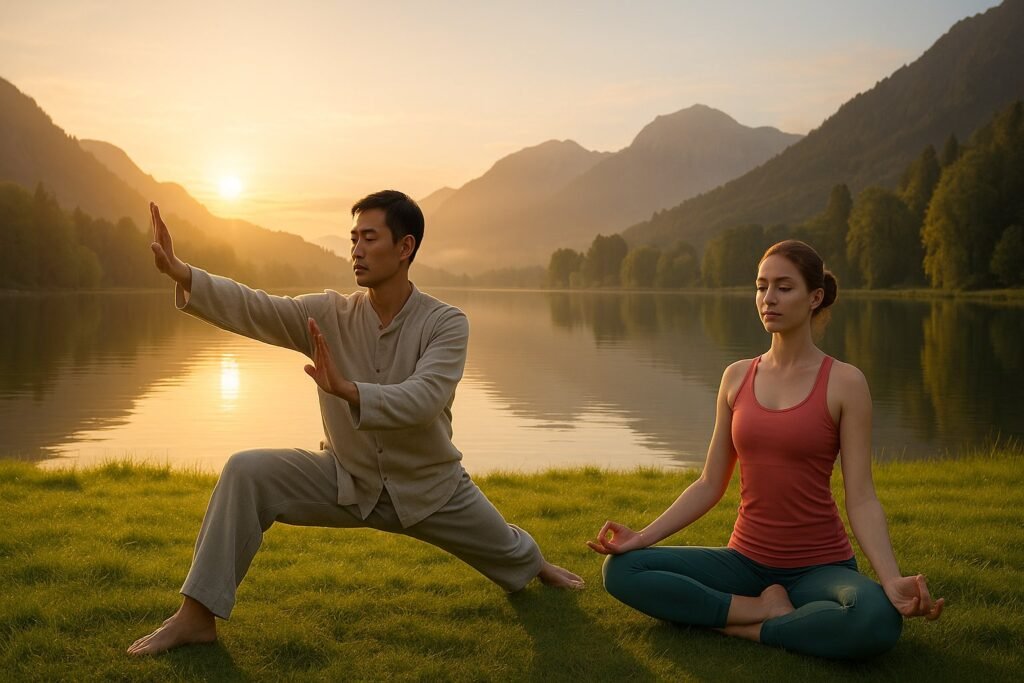
Tai Chi and yoga both help with balance, stress relief, and body awareness. Each uses its own take on movement, breathing, and mental focus to give you real benefits.
Movement and Posture
Tai Chi sticks to slow, controlled motions. Every step blends into the next, creating gentle, flowing movement. You’re always in motion, but never rushing or forcing things.
Yoga is all about holding postures (asanas) that stretch, strengthen, and balance your muscles. The pace depends on the style—some are slow, others more intense. You use your own body weight for strength and flexibility.
Both Tai Chi and yoga help you improve balance and posture. Practicing these movements can ease joint pain and help prevent falls, especially as you get older. Stick with it, and you’ll notice your muscles and stability improve. For details on these physical perks, check out tai chi’s impact on muscle strength, flexibility, and balance.
Breathing Techniques
Breathing is a big deal in both practices. In Tai Chi, you use deep belly breathing that matches your movements. Each inhale and exhale helps you relax and focus.
Yoga teaches several breathing styles (pranayama), like deep belly breathing and alternate nostril breathing. Some types of yoga use slow, steady breaths, while others go for quick, energizing ones. The main idea is to control your breath and let it guide your body and mind.
These breathing habits calm your nerves, lower blood pressure, and get your blood moving. Slow, steady breathing in both Tai Chi and yoga links closely to relaxation and better circulation.
Role of Mindfulness
Mindfulness is at the heart of Tai Chi and yoga. You pay attention to how your body moves, how you feel, and even what’s running through your mind. This active awareness keeps you present.
In Tai Chi, you focus on the feeling of each movement, where your limbs are, and the rhythm of your breath. In yoga, you watch your posture, sensations, and thoughts without judging—pretty much what you’d find in mindfulness-based stress reduction (MBSR).
Staying mindful during practice can ease stress, help you relax, and make you more resilient in daily life. Both are solid choices for lowering stress and finding inner calm.
Meditation and Mental Focus
Both Tai Chi and yoga work meditation into their routines. In Tai Chi, you get a kind of “moving meditation”—your mind stays steady and alert as you move. You keep your focus by syncing movement and breath.
Yoga usually sets aside time for quiet, seated meditation. This trains your attention and helps you let go of distractions. There are lots of meditation styles in yoga, from sitting still to repeating a phrase or just focusing on your breath.
Practicing meditation in either discipline can sharpen your focus, calm racing thoughts, and leave you feeling more at peace. Over time, you’ll probably notice more mental clarity and steadier emotions. The benefits of Tai Chi and yoga both back this up.
Physical Benefits of Tai Chi and Yoga
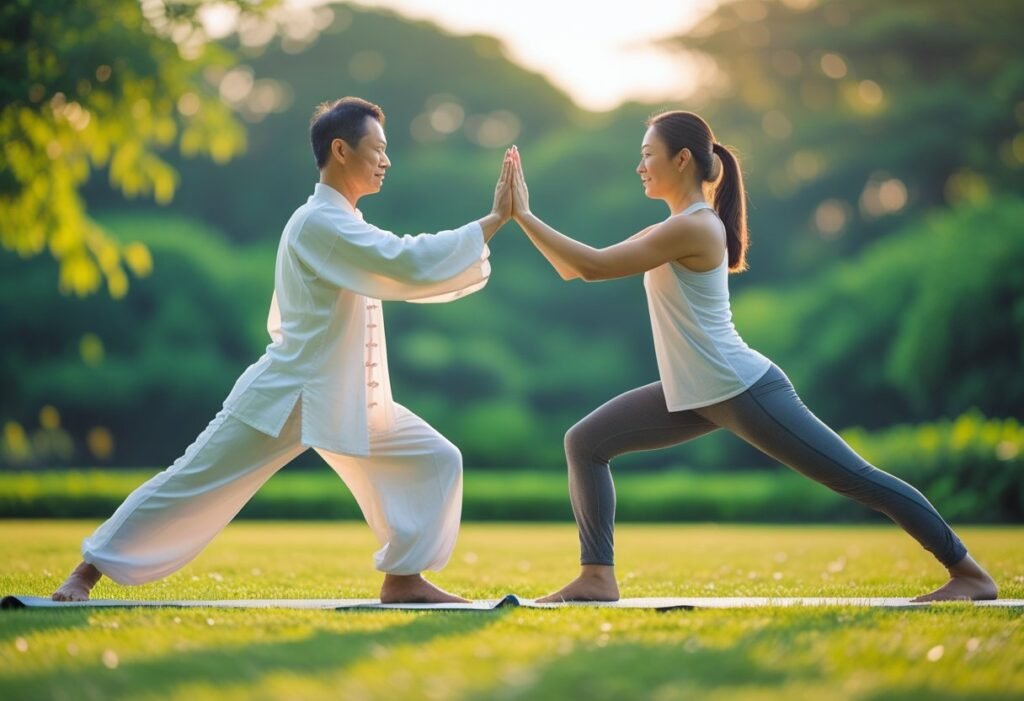
Tai Chi and yoga both boost your strength, flexibility, and body control. These low-impact exercises help you move better and feel steadier day to day.
Flexibility and Mobility
Tai Chi and yoga both help with flexibility through slow, controlled movement. Yoga stretches your shoulders, back, legs, and hips. Many poses keep your muscles in gentle tension, letting you loosen tight spots and keep your range of motion.
Tai Chi uses flowing forms that encourage your joints to move smoothly in all directions. This really helps with hip, knee, and ankle mobility. With regular practice, you’ll probably find it easier to bend, twist, and reach—without all the usual stiffness.
Either practice is great for easing tightness. Stick with it and you’ll likely increase flexibility and mobility, which is especially useful as you get older or bounce back from injuries.
Muscle Strength and Balance
Tai Chi and yoga give you a way to build strength without needing heavy weights. Yoga uses your own body weight for muscle work. When you hold poses like plank, downward dog, or warrior, you’re working your core, arms, and legs. Stick with it, and you’ll notice your muscles getting more stable and firm.
Tai Chi really targets your lower body—hips, thighs, calves—by making you shift weight slowly and keep your balance. Those steady, controlled steps mean your muscles have to stay engaged. Both yoga and Tai Chi also teach you how to react to shifts in balance, which can help keep you on your feet and avoid falls.
Falls become more of a concern as we age. Practicing these exercises might improve your balance and muscle strength, so daily stuff like walking or reaching for things feels safer and easier.
Improved Physical Function
Add yoga or Tai Chi to your week, and you might find the little things—tying shoes, climbing stairs, carrying bags—get easier. After just a few weeks, your joints could feel less stiff and achy.
Both are gentle, low-impact exercises that almost anyone can try, no matter your age or shape. Unlike high-impact workouts, these don’t pound your knees, hips, or back.
Research says regular practice can fix your posture, boost coordination, and sharpen your reaction time. That means you’re more likely to stay steady and avoid injuries when you’re out and about.
Mental and Emotional Benefits
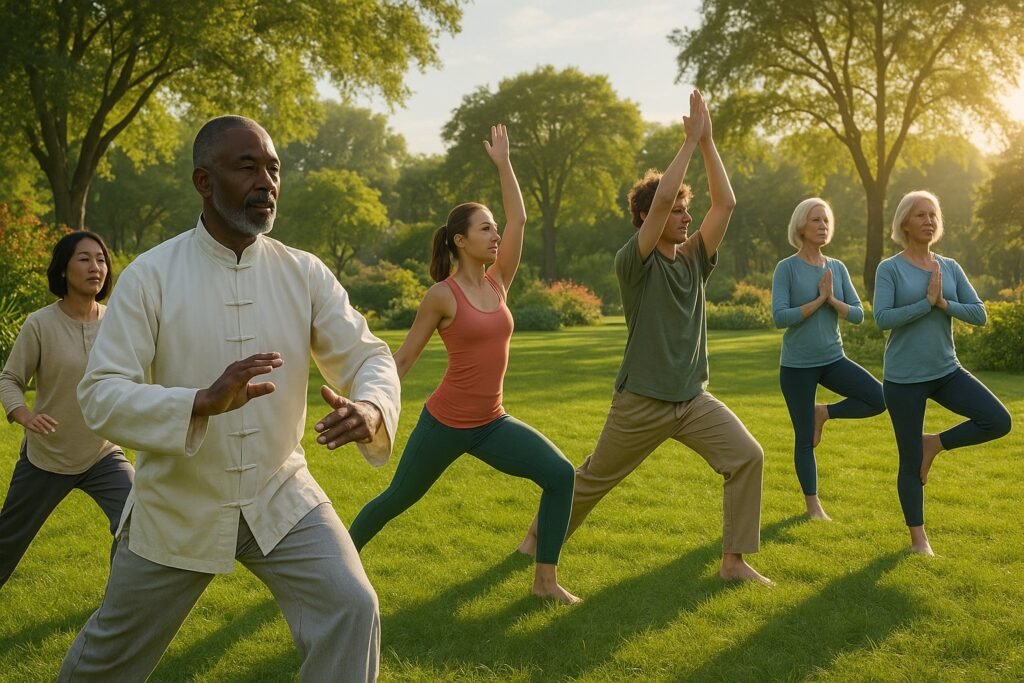
Both Tai Chi and yoga can help you manage stress, support your emotional health, and help you focus. They mix movement and deep breathing to bring a little more balance to your day-to-day life.
Stress Reduction and Relaxation
Tai Chi’s slow moves and steady breathing help your body and mind unwind. As you follow the flow, your heart rate drops and your muscles let go of tension. That shift from feeling wired to feeling calm is pretty noticeable.
Yoga has its own set of poses and breathing exercises to calm your nerves. Most classes end with a relaxation phase, so you can let go of whatever stress you carried in. Either practice can help you feel more peaceful and maybe even sleep better.
Doing Tai Chi or yoga can ease anxiety. For lots of folks, these activities lower cortisol (the stress hormone) and help you find a sense of calm that sticks with you. A recent study even found Tai Chi lowered anxiety and improved quality of life.
Boosting Psychological Well-Being
Practicing Tai Chi or yoga regularly might just lift your mood. These mind-body routines encourage you to pay attention to yourself and stay present, which can help with emotional balance.
Tai Chi helps people dealing with depression or stress-related struggles. It can make you feel more at home in your body and give you a bit more control over your emotions. For veterans and people under pressure, practicing Tai Chi has been linked to less anxiety and better well-being.
Yoga brings its own mental health perks. Breathing and meditation give you tools to handle negative thoughts. Over time, these tools can help you face life’s challenges and improve your psychological well-being.
Enhancing Cognitive Function
Tai Chi and yoga aren’t just for your body—they boost your brain, too. The focus Tai Chi requires sharpens your attention and mental clarity. You have to notice your balance, posture, and breathing all at once.
Yoga asks you to concentrate during poses and breathwork, which builds mental discipline. These habits might help you remember things better and keep your mind sharp as you get older. Studies suggest the mindful side of both practices can increase mental clarity and focus.
Stick with it, and you might find you remember details more easily or stay on task longer. That’s handy whether you’re at work or school.
Therapeutic Applications and Health Impact
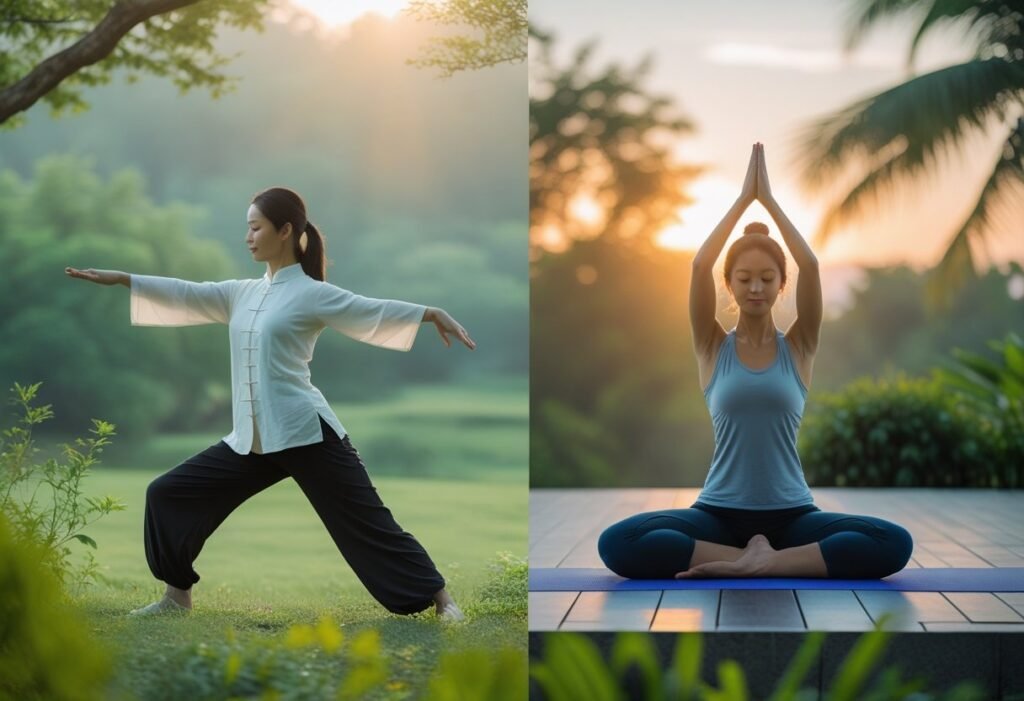
Tai Chi and yoga each bring something special to the table for wellness. They can help with pain relief, mental health, and healthy aging by focusing on gentle movement, breath, and mindfulness.
Chronic Pain and Inflammation Relief
If you deal with joint pain or issues like osteoarthritis, gentle movement from Tai Chi and yoga might help. Both use slow, controlled moves that don’t stress your joints but do improve flexibility and strength. Tai Chi especially has a reputation for strengthening joints and improving balance.
Moving regularly and focusing on your breath can sometimes help reduce chronic pain and inflammation, especially if you’re also living a healthy lifestyle. Doctors often use yoga and Tai Chi alongside other treatments to manage pain from things like back issues or arthritis.
| Practice | Pros for Pain | Additional Benefits |
|---|---|---|
| Tai Chi | Less joint load, increases flexibility | Improves balance, helps with stiffness |
| Yoga | Improves range of motion, gentle strengthening | Reduces muscle tension, improves posture |
Managing Anxiety and Depression
Tai Chi or yoga can help you manage anxiety and depression by shifting your focus, calming your mind, and encouraging relaxation. Both use slow, deep breaths and mindful movement, which may lower stress hormones and support a better mood.
Tai Chi has helped some people with anxiety and depression. Some even report remission or fewer symptoms after regular practice. Yoga also helps by promoting relaxation and letting go of physical tension.
You might notice you sleep better, have fewer racing thoughts, or feel more in control emotionally. Practicing regularly can help you cope with stress, and it can work alongside therapy or medication if you need it.
Benefits for Older Adults
Tai Chi is a favorite for older adults because it boosts balance, coordination, and helps prevent falls. The slow movements make it a good fit for people with limited mobility or chronic pain. Practicing Tai Chi regularly can improve muscle strength and flexibility, too.
Yoga is good for seniors as well, but Tai Chi has more research behind it for safety and benefits in aging adults. Both can help you feel more confident and independent, though Tai Chi may give extra support if you worry about balance or falling.
Some research says Tai Chi might help people with cognitive decline or early dementia, and yoga can boost overall wellness for older folks. These gentle movement practices are worth considering if you want to stay independent and keep your mind and body healthy as you age.
Tai Chi vs Yoga: Choosing the Right Practice
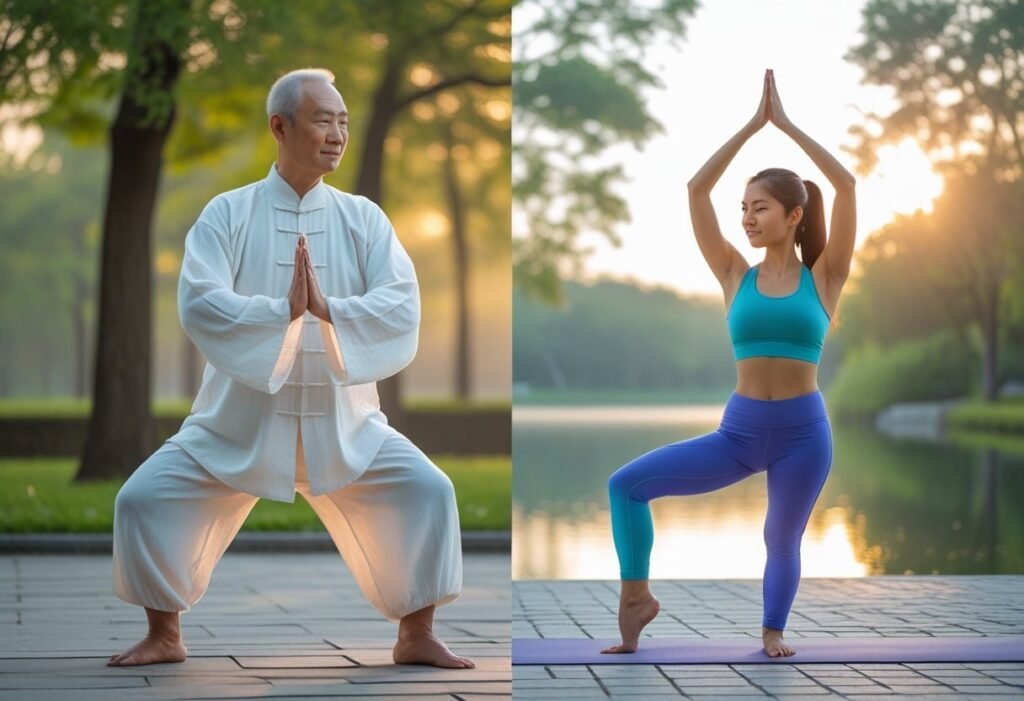
Tai Chi and yoga both connect mind and body, but they’re different in pace, techniques, and what you get out of them. The best choice depends on your health goals, fitness level, and what you’re hoping to get from your wellness routine.
Personal Goals and Lifestyle
Think about what you want. If you’re after relaxation, gentle movement, and better balance, tai chi might be your thing. It’s low impact, with flowing movements, and easy on the joints.
Yoga mixes physical poses, breathing, and meditation. Some types focus on stretching and flexibility, others build strength and stamina. If you want variety or a mix of mental and physical benefits, yoga could be more your speed.
If you’re recovering from an injury or struggle with mobility, tai chi is usually recommended—it’s soft and slow. If you’re craving a tougher workout, vigorous yoga styles might be better. Look at your daily routine and how much time you can actually put in.
Types of Tai Chi and Yoga Classes
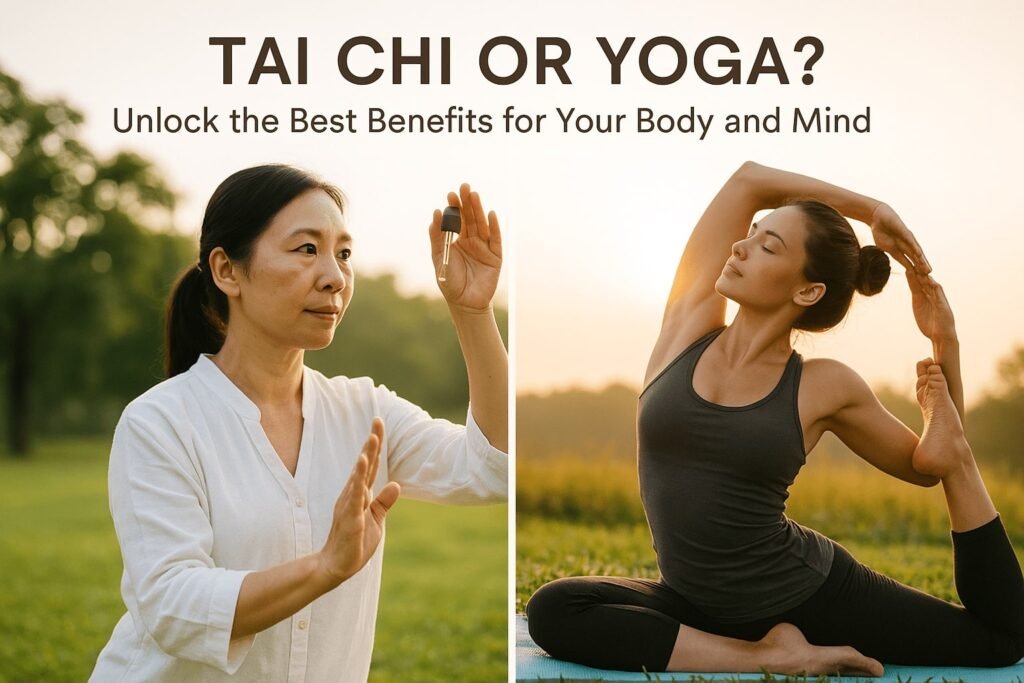
You’ll find all sorts of tai chi and yoga classes out there. Tai chi styles like Wu, Yang, and Chen each have their own rhythm and steps—Wu is especially gentle, while Chen gets a bit faster and trickier.
Yoga classes go from chill, meditative Hatha to intense Ashtanga or Vinyasa flows. Gentle yoga works for beginners, while power or hot yoga suits folks who want a challenge. Check out a few class descriptions at your local studio or gym to see what clicks.
Some places offer tai chi or yoga classes focused on wellness, like stress relief or pain management. Others blend movement with meditation. If you’re not sure what fits, try a beginner session and see how your body responds.
Safety and Accessibility
Tai chi’s pretty safe for most ages and fitness levels. The slow, low-impact moves are easy on the body, and instructors can tweak them for beginners or folks with health concerns. If you’re after gentle, low-impact exercise, tai chi gives you routines that help with balance and lower your risk of falling.
Yoga classes are all over the map in terms of difficulty. Gentle yoga works well for beginners and older adults, but advanced classes might push your flexibility and strength. Some poses can stress your joints—so if you’ve got injuries or chronic pain, tell your instructor upfront.
Both have accessible options: look for beginner or chair yoga, or community and senior-focused tai chi. Lots of studios now run online sessions, so you can start from home if that’s easier.
With some guidance and by respecting your own limits, both practices can help you move safely and feel better overall. If you’re curious about how their structure affects accessibility, here’s a deeper dive.
Integrating Tai Chi or Yoga Into Daily Life
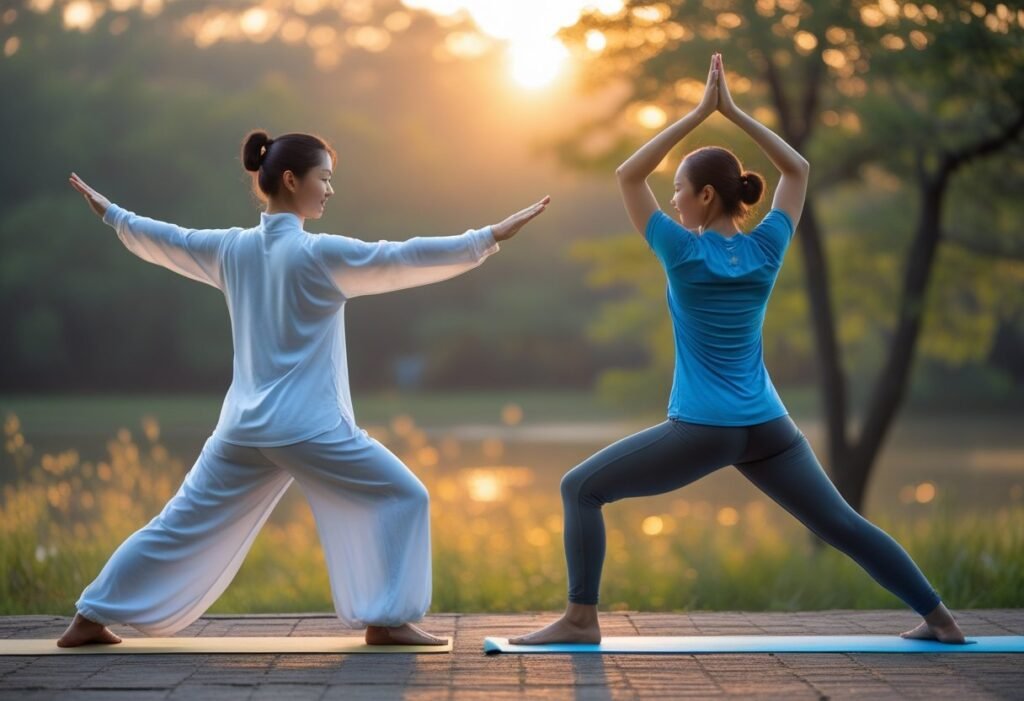
Adding Tai Chi or yoga to your day can boost your well-being, help you move better, and just make you feel a bit more relaxed. You don’t need fancy gear, so most people can jump in without much fuss.
Getting Started and Building a Routine
Pick a time when you usually feel awake and comfortable. Lots of people start with 10–20 minutes in the morning or evening. Find a quiet spot—at home, in a park, wherever you like. No need to splurge on equipment; comfy clothes and a mat or just a flat surface are fine.
Begin with the basics. Learn a few poses or movements, maybe from a video, book, or local class. Set a reminder on your phone until it becomes a habit. Even a few minutes daily can help you feel calmer and move more easily. Mixing in both yoga and Tai Chi keeps things from feeling stale.
Mark your sessions on a calendar. This tiny step can keep you motivated, especially when you start to notice small wins—like feeling looser or less stressed.
Tips for Long-Term Practice
Stick with a routine that actually fits your life. Miss a day? No big deal—just start again tomorrow. Consistency matters way more than cramming in long sessions every now and then.
Practicing with a friend or group can make things more fun. Classes, whether online or in person, give you some structure and encouragement. Plus, sharing the experience adds a social boost that’s honestly pretty nice.
If you feel pain, stop and tweak what you’re doing. Pay attention to your body; don’t force it. Over time, you’ll probably notice better balance, less stress, and maybe a bit more ease in your day. If you want more tips on weaving mind-body exercise into daily life, here’s a handy list.
Frequently Asked Questions
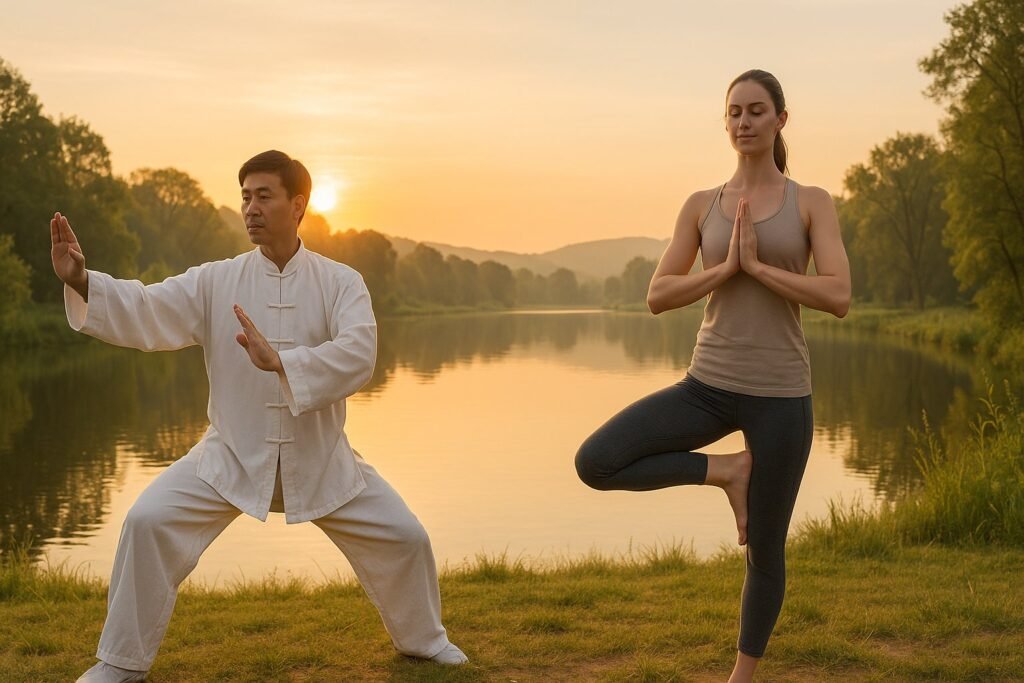
Tai Chi and Yoga each bring their own mental and physical perks. Both can lower stress, help your joints, and boost balance and flexibility.
Which practice is more beneficial for mental health, Tai Chi or Yoga?
Both Tai Chi and Yoga help reduce stress and bring a sense of calm. You’ll find slow movements and mindful breathing in each, which makes it easier to relax and focus. Tai Chi flows from one move to the next, while Yoga mixes movement and stillness for mental clarity.
Can practising Tai Chi or Yoga lead to better weight management?
Neither Tai Chi nor Yoga is super intense, but if you stick with it, you can maintain a healthy weight. They boost your body awareness, burn some calories, and might even nudge you toward healthier habits. Honestly, showing up regularly matters more than which practice you choose.
How does Tai Chi compare to Yoga for improving flexibility and balance?
Tai Chi’s all about slow, steady moves that build leg strength and balance. Yoga gets you holding different poses that stretch your muscles and improve flexibility. Both will help you see better balance and flexibility if you stick with them.
Which activity is more effective in managing symptoms of arthritis, Tai Chi or Yoga?
Gentle movement from both can ease stiff joints and help you stay mobile. Tai Chi is especially joint-friendly, so it’s often a good pick if arthritis limits your movement. Yoga can help too, but you’ll want to pick poses that don’t aggravate your joints.
What are the unique mental benefits of Tai Chi compared to Yoga?
Tai Chi is like meditation in motion. Those slow, flowing moves help you tune in to your body and your surroundings. This moving meditation can ease anxiety and sharpen your focus. Yoga’s great for the mind too, but the approach is a bit different.
How does the combination of Tai Chi and Yoga enhance overall well-being?
Mixing Tai Chi and Yoga supports your physical and mental health from different angles. Tai Chi’s gentle movement pairs well with Yoga’s stretches and poses. Doing both can help your heart, boost endurance, and improve balance—it’s a pretty well-rounded combo.
Conclusion
Tai chi and yoga both give you practical ways to care for your mind and body. Sure, they go about it a bit differently, but in the end, they’re both aimed at helping you feel healthier.
Tai chi builds steady balance, muscle strength, and keeps you moving smoothly. It’s gentle and works well if you’re looking for low-impact exercise. You’ll notice tai chi encourages deep breathing and mental focus, which can really help you unwind. If you’re curious, you can dive deeper into tai chi’s benefits at Harvard Health Publishing.
Yoga stretches your body and builds muscle in a different way. The poses help with flexibility, and the breathing exercises and meditation can help you feel more centered—maybe even a bit more relaxed, if we’re being honest.
Here’s a quick look at both practices:
| Tai Chi | Yoga | |
|---|---|---|
| Main focus | Gentle movement, balance | Flexibility, strength |
| Stress relief | Yes | Yes |
| Meditative | Yes | Yes |
| Flexibility | Some | High |
| Impact | Low | Low to moderate |
If you lean toward steady, flowing movement, tai chi might feel right. On the other hand, if you enjoy stretching and trying out different poses, yoga could be your thing. Or hey, maybe just try both and see which one clicks for you.




